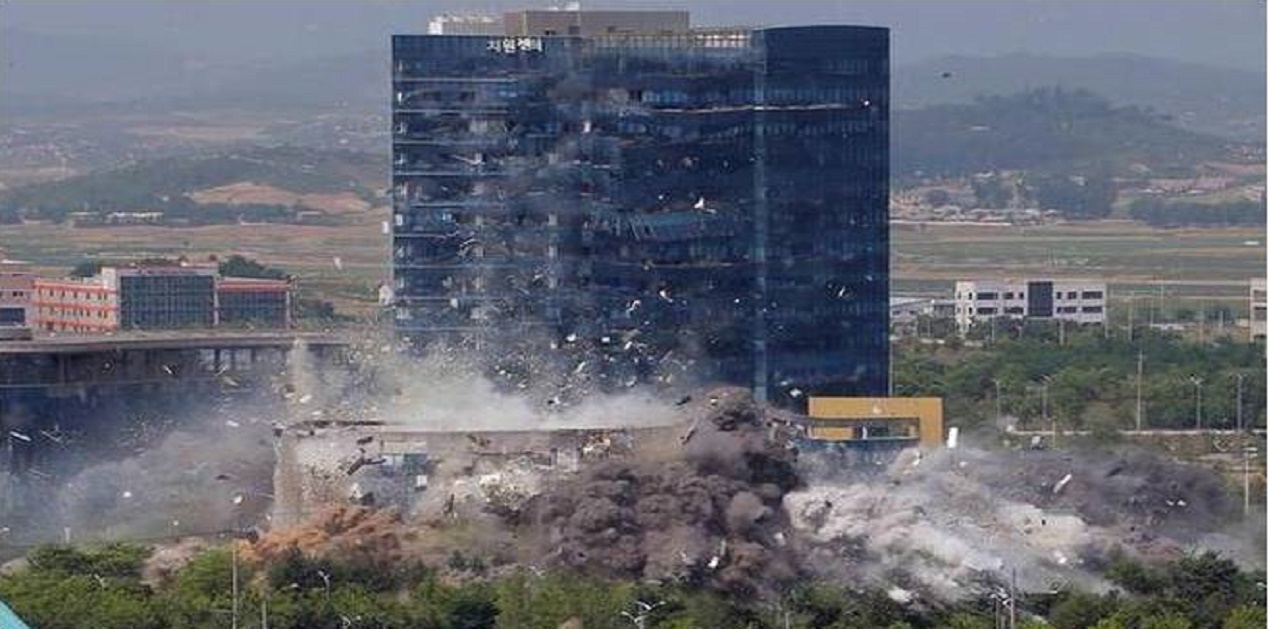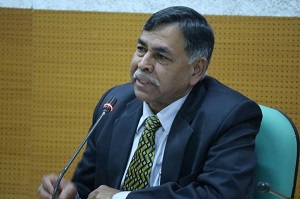At a time when the world attention is focussed in battling the Covid-19, two communist nations – China and North Korea – are engaged in different terrains as if to deflect the focus from containing Covid-19. Both are unfortunate developments and would serve no one’s interests. While China is embroiled in a stand-off with India on the disputed boundary issue in Ladakh, North Korea has virtually destroyed all prospects of inching towards achieving inter-Korean rapprochement and negating all sincere peace overtures made by the South Korean President Moon Jae-in by blowing up the Korean joint liaison office in Kaesong that was opened with much fanfare in September 2018 on 16 June, reducing it to rubble. This commentary focuses on the North Korean issue.
The decision to open this much hyped inter-Korean liaison office was part of an agreement that was reached between South Korean President Moon and North Korean leader Jim Jong-un in the first summit between the two in April 2018, facilitating with the unprecedented historic summit between the US President Donald Trump and North’s leader Kim Jong-un in Singapore in June 2018. Despite this and the subsequent second summit in Hanoi between the two in February 2019, both of which yielded no positive outcome, and despite the exchanges of unparliamentarily language such as “Little Rocket Man” and “fire and fury” by Trump for Kim, and “dotard” and “Frightened dog” by Kim for Trump, and continued missiles firing by Kim, Moon persevered as a peace broker. All such efforts yielded no results with Kim’s latest actions of blowing up the four-storey structure closed since January 2020 over fears of the Covid-19 pandemic, which North Korea’s KCNA state news agency proudly termed as “tragically ruined with a terrific explosion”.1
The blast was so powerful that it also affected partially a tall building nearby, a 15-storey residential facility that housed staff of the liaison office. President Moon took this initiative with a view to help the North economically and the government spent a whopping $8.6 million to renovate the building and brought some shine to this industrial zone in Kaesong on the side of the North. Moon’s objective was to make this site as the first permanent physical communication centre facilitating contacts between the peoples of both sides on frequent basis as a prelude to establish long-term understanding, thereby achieving his twin objective of achieving economic growth in the North and soft-power diplomacy. The destruction of the building in totality is a major setback to his efforts to make peace with the North.
After showing initial promise and fervent activities that led to the first Trump-Kim summit in Singapore, the fiasco in the second summit in Hanoi started to undo all what Moon had assiduously persevered in his peace efforts. He had hoped that military tensions would ease and now with the building’s destruction, Moon would be the most disappointed man as all his previous efforts seem to have come to a nought.
Kaesong’s Past
Kaesong, as the joint industrial complex, has an interesting past. This industrial site was initially part of the South which Moscow and Washington divided the peninsula in the closing days of World War II. However, at the end of the 1950-53 Korean War that ended in an armistice rather than a peace treaty, Kaesong went to Northern side. Though this joint industrial zone was developed in 2004 under the presidency of the liberal Roh Moo-hyun, the project came virtually to a halt when the hardliner President Park Geun-hye suspended all operations in 2016 in response to North Korea’s nuclear and missile tests. She suspected that the economic rent accrued from the project was being used for weaponization program rather than for the welfare of the people and economy. Unfortunately while Roh Moo-hyun committed suicide in 2009 leaping to his death from a hill behind his house, Park Geun-hye is now in jail serving a sentence on corruption charge.
What was the Provocation for Demolition?
Why did North Korea resort to this demolition of the building that was critical for the Kaesong industrial project, a chicken laying golden egg for the country? The decision to blast the liaison office came after a short period of vitriolic rhetoric led by Kim Jong-un’s powerful sister Kim Yo-jong who used unparliamentarily language like her brother against the South over leaflet issue. Pyongyang’s angry reaction started when activists along with defectors started sending anti-Pyongyang leaflets attached to hot air balloons or floated in bottles criticising the regime for human rights abuses and its nuclear ambitions over the border in the beginning of June 2020. This provoked Pyongyang, leading to the demolition of the liaison office.
Korea watchers were soon to conclude that in desperation to extract sanctions relief in negotiations with the US despite having two summits but without success, North Korea probably looked for another alibi so that it could increase pressure on Washington by dragging Seoul into the picture to address the nuclear issue. The purpose was to remain in international limelight.
Reactions
As expected the reaction from South was one of disappointment. In an emergency meeting, South Korea’s National Security Council cautioned Pyongyang not to aggravate the situation. The vice unification minister Suh Ho termed the demolition as “unprecedented in inter-Korean relations”2 and a “nonsensical act that should not have happened”. Though South Korea had already taken legal action against some activist groups for their acts in order not to provoke the North so that the dialogue process could continue, response from the North came in the form of the demolition of the liaison office, which the state news agency KCNA said was in line with "the mindset of the enraged people to surely force human scum and those who have sheltered the scum to pay dearly for their crimes". Preceding the demolition, Pyongyang had already severed all official communications links with Seoul, including the military hot lines. Professor Leif-Eric Easley of Ewha University in Seoul is quoted to have called the destruction of the office “a symbolic blow to inter-Korean reconciliation and cooperation”.3 Other analysts expressed similar dismay. It looked it was a desperate cry by Pyongyang to draw attention, and as a build-up pressure tactic on Trump who shall be seeking re-election later this year.
Concerns were expressed that the peace process might be derailed. Russia called for restraint from all sides. Moon appealed to the North not to “close the window of dialogue”,4 urging the North to respect and abide by the 2018 agreement.5 From Pyongyang’s past behaviour it seems that the leaflets and balloons issues were just alibis; it just wanted to put pressure on Seoul so that it could persuade Trump to abide by promise made at Singapore to end all sanctions against the North since it had agreed to a moratorium to all nuclear activities. The truism is that what transpired both in Singapore and Hanoi summits remains unclear and unknown, leaving both sides free to interpret the summit outcome in their own ways as it suited them.
Somehow or other, Kim is keen to remain in the glaze of global eye. Having achieved his ambition to sit across the table on equal terms with the American President, not once but twice, but not conceding an inch from his nuclear position and sticking to his sanctions relief demands, the events raised some flicker of hope of peace returning to the Korean Peninsula. That did not happen but Kim grabbed global attention. Then when things started to cool down with no signs of sanctions relief in the horizon, Kim disappeared from public view for few weeks in April-May 2020, leading to speculation about his possible death and debates on regime stability as no possible alternative was in the realm. This drama continued for some time until the regime released photos of Kim inaugurating a fertilizer plant.6
Now when the world attention is focussed on Covid-19, Kim found the time opportune to make another try so that he could mount pressure to be recognised as a nuclear state as well as avail sanctions relief. By blowing up the liaison office and as a major setback to Moon’s engagement strategy, Kim has put Moon in a fix again to reach out to Trump.
Kim Jong-un has already announced his next step to deploy military units at the sites of the Diamond tourism project and the Kaesong industrial complex, besides resuming military exercises and re-establish guard posts in front-line areas.7 If North Korea goes ahead with such plans, these would effectively mean undoing of all that Moon worked for so assiduously since coming to power and render the 2018 tension-reduction deal meaningless.8 This also shows that there still exists huge trust deficit between the two sides. Yet, Moon ever an optimist is still hopeful that Kim Jong-un would reconsider his stand and return to dialogue, though the Blue House mildly reacted that it would no longer accept unreasonable behaviour by the North. So, both Trump and Moon are faced with a fresh challenge.
Endnotes
- “Office Politics: Symbol of inter-Korean liaison reduced to rubble”, 16 June 2020, https://www.channelnewsasia.com/news/asia/office-politics--symbol-of-inter-korean-liaison-reduced-to-rubble-12840348?cid=h3_referral_inarticlelinks_24082018_cna
- “North Korea blows up liaison office with South in Kaesong”, 16 June 2020, https://www.channelnewsasia.com/news/asia/north-korea-blows-up-liason-office-kaesong-south-korea-12840000?cid=emarsys-cna_20200617_0101_FINAL+CNA+Mon+to+Sat+newsletter+%280740%29_ne. Also, see, “N Korea destroys liaison office on border with South”, 17 June 2020, https://www.taipeitimes.com/News/front/archives/2020/06/17/2003738359
- Views quoted in Ibid.
- “President Moon asks North Korea to ‘not close the window of dialogue’”, 16 June 2020, https://www.rokdrop.net/2020/06/president-moon-asks-north-korea-to-not-close-the-window-of-dialogue/
- Under the agreement reached between Moon and Kim in 2018 during their summit meeting, both sides had vowed to restrain their militaries from "all hostile acts" and dismantle a number of structures along the heavily fortified Demilitarized Zone (DMZ) in the 38th Parallel Line of border city of Panmunjom.
- See, Rajaram Panda, “Kim is alive, but is he well enough to rule North Korea?”, 4 May 2020, https://www.rediff.com/news/column/kim-jong-un-is-alive-but-is-he-well-enough-to-rule/20200504.htm; Rajaram Panda, “Kim Jong-un resurfaces: Debates about North Korea’s future continues”, 4 May 2020, http://cescube.com/vp-kim-jong-un-resurfaces-debates-about-north-korea-s-future-continues
- “North Korea’s military to re-enter inter-Korea cooperation sites”, 17 June 2020, https://www.thehindu.com/news/international/north-koreas-military-to-re-enter-inter-korea-cooperation-sites/article31847775.ece?utm_source=email&utm_medium=Email&utm_campaign=Newsletter
- See, Rajaram Panda, “Despite Nuclear Stalemate, Moon Pursuing Inter-Korean Projects – Analysis”, 4 June 2020, https://www.eurasiareview.com/04062020-despite-nuclear-stalemate-moon-pursuing-inter-korean-projects-analysis/
(The paper is the author’s individual scholastic articulation. The author certifies that the article/paper is original in content, unpublished and it has not been submitted for publication/web upload elsewhere, and that the facts and figures quoted are duly referenced, as needed, and are believed to be correct). (The paper does not necessarily represent the organisational stance... More >>










Post new comment